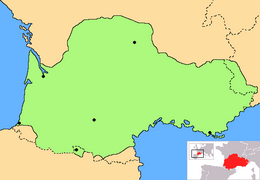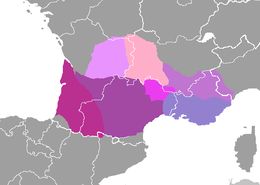ᱚᱠᱥᱤᱴᱟᱱ ᱯᱟᱹᱨᱥᱤ
ᱚᱠᱥᱤᱴᱟᱱ (ᱚᱠᱥᱤᱴᱟᱱ: occitan [utsiˈta]) ᱥᱮ ᱞᱤᱝᱜᱟ ᱰᱚᱠ (lenga d'òc) ᱧᱩᱛᱩᱢ ᱛᱮᱦᱚᱸ ᱵᱟᱲᱟᱭᱚᱜᱼᱟ, ᱱᱚᱶᱟ ᱫᱚ ᱢᱤᱫ ᱨᱳᱢᱟᱱᱥ ᱯᱟᱹᱨᱥᱤ ᱠᱟᱱᱟ ᱾ ᱚᱠᱥᱤᱴᱟᱱ ᱯᱟᱹᱨᱥᱤ ᱠᱚᱧᱮ ᱯᱷᱨᱟᱱᱥ, ᱢᱳᱱᱟᱠᱳ, ᱤᱴᱟᱞᱤ ᱨᱮᱱᱟᱜ ᱚᱠᱥᱤᱴᱟᱱ ᱵᱮᱰᱟ, ᱚᱱᱟ ᱥᱟᱶ ᱮᱥᱯᱮᱱ ᱨᱮᱱᱟᱜ ᱵᱷᱟᱞ ᱰᱤᱟᱨᱟᱱ ᱴᱚᱴᱷᱟ ᱨᱮᱠᱚ ᱨᱚᱲᱼᱟ ; ᱱᱚᱶᱟ ᱠᱚ ᱟᱫᱚᱢ ᱡᱚᱠᱷᱮᱡ ᱚᱠᱥᱤᱴᱟᱱᱤᱭᱟ ᱦᱚᱠᱚ ᱢᱮᱛᱟᱜ ᱜᱮᱭᱟ ᱾ ᱑᱙ ᱥᱟᱭ ᱥᱮᱨᱢᱟ ᱨᱮᱱᱟᱜ ᱢᱩᱪᱟᱹᱫ ᱦᱟᱹᱵᱤᱫ ᱠᱟᱛᱟᱞᱟᱱ ᱯᱟᱹᱨᱥᱤ ᱚᱠᱥᱤᱴᱟᱱ ᱯᱟᱹᱨᱥᱤ ᱨᱮᱱᱟᱜ ᱢᱤᱫ ᱪᱟᱸᱜᱟ ᱯᱟᱹᱨᱥᱤ ᱠᱟᱱᱟ ᱢᱮᱱᱛᱮ ᱠᱚ ᱢᱚᱱᱮᱭᱮᱫ ᱛᱟᱦᱮᱫ,[᱑᱐] ᱟᱨ ᱱᱟᱦᱟᱜ ᱫᱤᱱ ᱦᱚᱸ ᱱᱚᱶᱟ ᱯᱟᱹᱨᱥᱤ ᱥᱟᱶ ᱟᱹᱰᱤ ᱥᱩᱨᱼᱥᱩᱯᱩᱨ ᱥᱟᱹᱜᱟᱹᱭ ᱢᱮᱱᱟᱜ ᱜᱮᱭᱟ ᱾[᱑᱑]
| ᱚᱠᱥᱤᱴᱟᱱ | |
|---|---|
| occitan, lenga d'òc, provençal | |
| ᱡᱟᱱᱟᱢ ᱴᱷᱟᱶ | ᱯᱷᱨᱟᱱᱥ, ᱮᱥᱯᱮᱱ, ᱤᱴᱟᱞᱤ, ᱢᱳᱱᱟᱠᱳ |
| ᱡᱟᱹᱛ | ᱚᱠᱥᱤᱴᱟᱱᱥ |
ᱡᱟᱱᱟᱢ ᱯᱟᱹᱨᱥᱤ ᱞᱮᱠᱟ | ᱥᱟᱱᱟᱢ ᱨᱮ ᱟᱢᱫᱟᱡᱽ ᱦᱚᱲ ᱮᱞ ᱑᱐᱐,᱐᱐᱐ ᱠᱷᱚᱱ ᱘᱐᱐,᱐᱐᱐ (᱒᱐᱐᱗–᱒᱐᱑᱒),[᱑][᱒] ᱖᱘,᱐᱐᱐ ᱤᱴᱟᱞᱤ ᱨᱮ (᱒᱐᱐᱕ ᱦᱚᱲ ᱞᱮᱠᱷᱟ ᱡᱚᱠᱷᱟ),[᱓] ᱔,᱐᱐᱐ ᱮᱥᱯᱮᱱ ᱨᱮ (ᱵᱷᱟᱞ ᱰᱤᱟᱨᱟᱱ)[᱔] |
ᱢᱟᱬᱮ ᱚᱠᱥᱤᱴᱟᱱ
| |
| Dialects | |
ᱚᱞ ᱛᱚᱦᱚᱨ | ᱞᱟᱛᱤᱱ ᱦᱚᱨᱚᱯ (ᱚᱠᱥᱤᱴᱟᱱ ᱪᱤᱠᱤ) |
| ᱥᱚᱨᱠᱟᱨᱤ ᱢᱟᱱᱚᱛ | |
ᱟᱹᱢᱟᱹᱞᱮᱛ ᱯᱟᱹᱨᱥᱤ ᱴᱚᱴᱷᱟ | (ᱮᱥᱯᱮᱱ) |
ᱞᱮᱠᱷᱟᱥᱤᱫ ᱯᱟᱹᱨᱥᱤ ᱢᱟᱹᱱ ᱮᱢᱟᱠᱟᱱ ᱴᱷᱟᱶ | |
| ᱥᱟᱢᱵᱽᱲᱟᱣᱤᱭᱟᱹ | ᱚᱠᱥᱤᱴᱟᱱ ᱯᱟᱹᱨᱥᱤ ᱠᱟᱭᱩᱱᱥᱤᱞ;[᱖] Congrès Permanent de la Lenga Occitana;[᱗] Institut d'Estudis Aranesi[᱘] |
| ᱯᱟᱹᱨᱥᱤ ᱠᱳᱰ | |
| ISO 639-1 | oc |
| ISO 639-2 | oci |
| ISO 639-3 | oci – inclusive codeIndividual code: sdt – Judeo-Occitan |
| ᱜᱞᱳᱴᱳᱞᱳᱜᱽ | occi1239[᱙] |
| ᱯᱟᱹᱨᱥᱤ ᱴᱚᱴᱷᱟ | 51-AAA-g & 51-AAA-f |
 | |
 Various dialects of Occitan
| |
ᱧᱩᱛᱩᱢ
ᱥᱟᱯᱲᱟᱣᱱᱟᱜᱟᱢ
ᱥᱟᱯᱲᱟᱣᱚᱛᱱᱚᱜ ᱪᱷᱮᱨ
ᱥᱟᱯᱲᱟᱣᱪᱟᱸᱜᱟ ᱯᱟᱹᱨᱥᱤ
ᱥᱟᱯᱲᱟᱣᱟᱨᱦᱚᱸ ᱧᱮᱞ ᱢᱮ
ᱥᱟᱯᱲᱟᱣᱵᱟᱨᱦᱮ ᱡᱚᱱᱚᱲ
ᱥᱟᱯᱲᱟᱣ| Look up Category:Occitan language in Wiktionary, the free dictionary. |
- Orbilat.com – Overview and grammar of Occitan
- Occitanet.free.fr – a guide to the language
- Globegate.UTM.edu – Troubadour & Early Occitan Literature
- Ostaldoccitania.net Archived ᱒᱐᱑᱑-᱐᱑-᱐᱖ at the Wayback Machine. – The house of Occitan associations of Toulouse
- Eonet.ne – "LexRomEdic", electronic version of Lexique Roman of Rainouard (A provisional version is available).
- arrilemosin.fr – Occitan Limousin group website with maps and vocabulary
- Bastir Occitanie – Apprendre l'occitan : ÊTRE / AVOIR au présent de l'indicatif [+ English, español] – To be, to have in Occitan language
ᱥᱟᱹᱠᱷᱭᱟᱹᱛ
ᱥᱟᱯᱲᱟᱣ- ↑ Bernissan, Fabrice (2012). "Combien l'occitan compte de locuteurs en 2012?". Revue de Linguistique Romane (in ᱯᱷᱨᱮᱧᱪ). 76: 467–512.
- ↑ Martel, Philippe (December 2007). "Qui parle occitan ?". Langues et cité (in ᱯᱷᱨᱮᱧᱪ). No. 10. Observation des pratiques linguistiques. p. 3.
De fait, le nombre des locuteurs de l'occitan a pu être estimé par l'INED dans un premier temps à 526 000 personnes, puis à 789 000 ("In fact, the number of occitan speakers was estimated by the French Demographics Institute at 526,000 people, then 789,000")
- ↑ Enrico Allasino; Consuelo Ferrier; Sergio Scamuzzi; Tullio Telmon (2005). "Le Lingue del Piemonte" (PDF). IRES. 113: 71 – via Gioventura Piemontèisa.
- ↑ Enquesta d'usos lingüístics de la població 2008 [Survey of Language Use of the Population 2008] (in Catalan), Statistical Institute of Catalonia, 2009
{{citation}}: CS1 maint: unrecognized language (link) - ↑ Norme in materia di tutela delle minoranze linguistiche storiche, Italian parliament
- ↑ CLO's statements in Lingüistica Occitana (online review of Occitan linguistics).Lingüistica Occitana: Preconizacions del Conselh de la Lenga Occitana (PDF), 2007
- ↑ "Page d'accueil". Région Nouvelle-Aquitaine – Aquitaine Limousin Poitou-Charentes. Archived from the original on 2012-01-27. Retrieved 2020-10-16.
- ↑ "Reconeishença der Institut d'Estudis Aranesi coma academia e autoritat lingüistica der occitan, aranés en Aran" [Recognition of the Institute of Aranese Studies as an academy and linguistic authority of Occitan, Aranese in Aran]. Conselh Generau d'Aran (in Aranese). 2 April 2014.
{{cite web}}: CS1 maint: unrecognized language (link) - ↑ Hammarström, Harald; Forkel, Robert; Haspelmath, Martin, eds. (2017). "Occitan". Glottolog 3.0. Jena, Germany: Max Planck Institute for the Science of Human History.
{{cite book}}: Unknown parameter|chapterurl=ignored (help) - ↑ Friend, Julius W. (2012). Stateless Nations: Western European Regional Nationalisms and the Old Nations. Palgrave Macmillan. p. 80. ISBN 978-0-230-36179-9. Retrieved 5 March 2016.[permanent dead link]
- ↑ Smith & Bergin 1984, p. 9